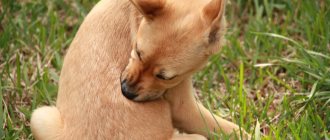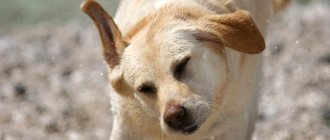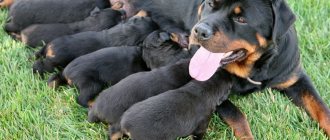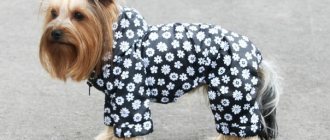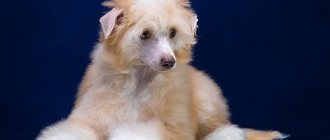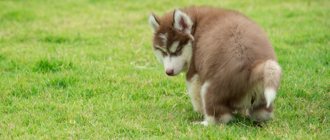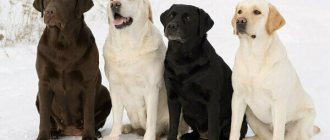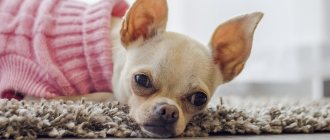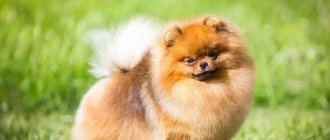Classification of burrow rocks
Breeds that were bred to improve hunting skills are called burrowing breeds. These species are adapted to work in animal shelters. The exterior of the species was carefully thought out and developed in compliance with all “hunting” requirements. The intelligence of the breeds does not fail either. Dogs cope with complex tasks with ease and are easy to train.
Burrowing dogs
Table 1. Categories of burrowing dogs.
| Category | Characteristic | Popular breeds |
| Workers | Dogs that have retained the instinctive skills of hunters. Having undergone special training - baiting - they become skilled catchers of small animals. | Dachshund, Jagdterrier, Cairn terrier |
| Part-time workers | Breeds, selective work on which was not based on the development of hunting skills. Theoretically, such a dog will cope with catching, but its exterior is not adapted for visiting holes. | Kerry Blue, Manchester Terrier |
| Non-working | Breeds belonging to the hunting group of terriers, but not capable of hunting. Such animals are bred as pets, which was the main reason for the loss of “agility”. | Yorkshire and Japanese Terrier, Russian Toy |
Categories of burrowing dogs
The FCI catalog classification unites most burrowing dogs into the third group (“Terriers”). All these breeds were bred at different times and in different countries for one purpose - hunting animals living in burrows. Such a hunt required special working qualities and skills from four-legged helpers. Today, more than thirty terriers with a rich hunting past are known, but the actual use of these dogs allows us to divide them into three categories:
- working breeds;
- semi-working breeds;
- decorative breeds.
Burrowing dogs are endowed with special qualities and working skills
Most Popular
Among the hunting breeds, it is worth noting the real favorites of animal hunting. Despite the wide range of species, these breeds remain at the peak of popularity.
Dachshund
The most popular burrow breed was bred four centuries ago. Since then, the little hunter's character has become concentrated and strengthened. The breed's instinct is often called hypertrophied. The owner is only engaged in polishing his innate skills.
Dachshund
Depending on their size, dachshunds are divided into several types:
- Standard. Weight exceeds 7 kg and often reaches 15. Height at the withers is about 23 cm. The exterior is powerful with a clear advantage in the front section - a strong chest and a narrow pelvis. The paws are short, strong, and set crookedly, so that the dog can conveniently jump out of the hole. The muzzle is elongated, the ears are drooping with rounded ends.
- Long-haired. Similar build to the previous one, but long hair.
Longhaired dachshund
- Rabbit dachshund. A breed that exactly copies its “big” brothers, but does not grow more than 5 kg. The rabbit dachshund can have either smooth or long hair.
The dachshund has long established itself as an ideal pet. Unpretentious in content. She is entirely devoted to the life of the owner, equally willing to live on the couch and in the field.
Dachshund corners badger
He understands commands instantly and learns quickly. However, he only carries out those orders that he considers appropriate. Innate pride and independence are combined in this dog with obstinacy.
The Dachshund is a companion breed, so it needs a lot of attention. Loneliness is not tolerated well, as is competition with other pets in the house. Willful and requires patient training and respect.
Training your dachshund is very important. If you do not start raising a puppy in infancy, it will try to subjugate its owner and will soon become the main dictator at home. You can read more about how to train a dachshund in our separate article.
Jagdterrier
The dexterous and courageous Jagdterrier takes an honorable second place in popularity among small burrowing breeds. It copes not only with small game, but also with birds and hoofed prey.
Jagdterriers after a successful hunt
Over the hundred years of its existence, the Jagdterrier has won the hearts of hunters. Its exterior is ideal for burrow hunting:
- dry compact body;
- weight on average reaches 10 g, height at withers - 38 cm;
- strong muscles and strong limbs;
- long muzzle;
- two-layer coat with a thick undercoat.
The Jagdterrier is a concentration of courage and aggression. This is the strongest temperament concentrated in a miniature breed. The Jagdterrier is completely incapable of fear. He fearlessly rushes into the badger's hole, filled with hunger to realize his potential.
A small dog with a strong character
For such high-quality data, the owner will have to pay with patience. Training a Jagdterrier is difficult. This is a breed with a difficult character and unshakable temperament. A stubborn and stern dog will certainly try to gain the upper hand in his own “pack”. He respects the owner, but is ready to argue and demonstrate an obstinate disposition.
Cairn Terrier
The Cairn Terrier is a breed that combines the instinct of a hunter and a pretty appearance. The first cores were bred for hunting fur-bearing animals in rocky areas, as well as for protecting homes from rodents. Later, the breed was improved by “training” it for a wider range of hunting skills. Today, the core can easily drive out a fox, handle waterfowl and run over a raccoon dog.
Cairn Terrier
The appearance of an adult Cairn Terrier is specific. Its height reaches 28 cm, weight - about 6-7 kg. The highlight of the exterior was the disheveled fur, reminiscent of a sloppy little devil.
It was the “plumage” that became the reason for the low popularity of the breed as a pet. This also became the core’s trump card. It was bred only by avid hunters, thereby perfecting the instincts of the breed.
The Cairn Terrier breed lends itself well to training and education.
Today, it is difficult to trace the pedigree of the core. Not only purebred representatives, but also Skye Terriers, as well as their Scottish counterparts, took part in the formation of the breed.
Skye Terrier
The Cairn Terrier is a brave and determined dog. As befits a brave hunter, she is not meek and is ready to go against the command. The cunning and assertive core will easily shake the patience of even the most experienced dog handler. The choleric disposition needs an individual approach - the cairn will not wait for a command if a hare appears on the horizon. The dog realizes its instincts, no matter what the cost.
I see the prey, I see no obstacles
In apartment conditions, you can give free rein to your active disposition during training. It is enough to teach the core the command “Search!” and periodically hide his toys in rocks and thickets.
Terriers never used for hunting
Despite the fact that all the breeds below are called terriers, they have never been used for burrow hunting. They were bred exclusively as decorative pets, absolutely not suitable for hunting.
Australian Terrier
A small, decorative dog with a difficult character. They love to bark loudly, chew shoes and furniture, are extremely active and restless, and are good at catching mice. With proper training and socialization, they get along well with dogs of the opposite sex. Otherwise, the tendency to dominate will cause certain inconvenience.
They were originally bred to hunt small rodents, but today they are no longer used for hunting.
Australian Silky Terrier
Externally, the dog is very similar to the Yorkshire terrier, but has the character of a real hunter. The Silkie Terrier is an active, intelligent, cunning and attentive pet. It belongs to the decorative indoor breeds, but requires competent and strict training and daily physical activity.
Due to its difficult temperament, it does not get along with other pets and is difficult to train and socialize.
Read about Australian Silky Terriers in the full article.
West Highland White Terrier
The breed was developed in Scotland specifically for fox hunting, but recently it has been considered decorative. He has an easy-going, sociable character and loves to play with children and other pets. The dogs are very graceful, energetic and courageous, they are hyperactive and persistent, and they learn commands well.
It is not recommended to let the dog off the leash, as it may instinctively chase the intended prey and accidentally fall under the wheels of a car.
We offer you to read a complete review of the West Highland White Terrier dog breed.
Yorkshire Terrier
One of the oldest breeds, whose origin is completely unknown. During its formation, the breed was actively used for hunting rats and gophers. Now the breed belongs to the class of decorative, domestic dogs.
Despite this, the breed has a courageous, fearless character, is easy to train and senses the mood of its owner. The main thing is to find an approach to the dog and make friends with it.
All about keeping Yorkshire Terrier dogs in the full article.
Russian toy
This is the smallest terrier in the world, which has nothing to do with hunting. The weight of an adult dog rarely exceeds 2.5 kg, they have very thin bones and weak muscles. Often representatives of this breed have an unstable psyche, but an absolutely healthy pet is distinguished by devotion, playful and mischievous character, and obedience.
It is worth considering that these dogs are very painful and require increased attention. They are smart and easily remember basic commands.
Learn more about the smallest of the terriers, the Russian Toy.
Japanese (Nihon) Terrier
The rarest, endangered breed of dog. Some representatives are found only in their homeland, Japan. The breed was bred as a decorative, indoor breed, not related to hunting.
The dogs are distinguished by their neatness, cleanliness, easy-going, easy-going and active disposition. The breed is characterized by love, positivity, devotion to the owner, easy excitability, sharp intelligence, and excellent guarding qualities.
Popular working breeds
When classifying working species, one cannot fail to mention the fox terrier, a dog bred specifically to work with foxes.
Fox Terrier in training
The size of an adult dog is quite compact: height at the withers reaches 38 cm, and weight is only 8 kg. Fox Terriers come in long-haired and smooth-haired varieties. Small dimensions go well with the innate endurance of the Fox Terrier. This is a strong, muscular dog, endowed with remarkable courage and determination.
Jack Russell Terrier
The Jack Russell Terrier is a miniature star of the burrow races. The height of an adult Jack Russell is 30 cm. The physique is flexible, the muscles are well developed.
Jack Russell at work
Active and hardy, he enjoys participating in hunting trips. Working and training the breed is a great pleasure, because in addition to their innate agility, Jacks are famous for their sociable disposition.
When this dog gets into the family, the new owners realize that they have acquired a real little devil. This small animal, without intensive training and strict upbringing, can destroy the entire apartment. And his character is a real test for the nerves of the owners. You can read more about how to train a Jack Russell Terrier puppy in our separate article.
Airedale
The Airedale Terrier is an excellent all-round hunter. The breed is suitable for hunting in holes, as well as for catching ducks and working with large animals. The height of the Airedale Terrier slightly exceeds the classic measurements of burrowing species - 60 -62 cm.
Looking out for prey
The Airedale Terrier is quite intelligent and proactive. Capable of hunting even without the participation of a hunter. The dog copes well with prey, killing it on its own. Quite smart and easy to make contact with. The breed is often started as a working breed.
Border Terrier
A medium-sized hunter with a well-developed sense of smell. Copes with driving out foxes, badgers and other animals. In addition to his innate skills, he is known for his friendly disposition. An undeniable advantage of the breed is its strong immunity.
Border Terriers and a Captured Fox
Norfolk Terrier
Miniature hunter bred in England. Its height reaches 25 cm, the weight of an adult animal is 4-5 kg. The compact exterior allows the breed to hunt not only foxes and badgers, but also ferrets, rats and rabbits.
Norfolk on a walk
The character of Norfolk is truly English. This is a wise and reserved dog, carefully controlling its strong temper. They are friendly and patient, making them suitable as an apartment pet.
Burrowing pets with working abilities
All dogs that have retained their working burrowing qualities undergo a special training course - baiting. Training is carried out in conditions close to natural. Experimental animals are used as bait.
In this category, the leading position is occupied by the dachshund. There are still legends about the origin of the breed, despite its antiquity, however, according to official data, the dachshund appeared in Germany, where it was bred through strict selection and crossing of hounds. The dog was used exclusively for its intended purpose - catching animals living in burrows. But dachshunds differ from other types of terriers in their moderate aggression towards the animal.
According to the official recognition of the International Canine Association, there are 3 main types of dachshunds:
- long-haired – has long guard hairs, less common due to complex coat care;
- standard - slightly different from the first type in the structure and length of the coat;
- rabbit - characterized by a small weight - no more than 5 kg, the length of the wool can be either short or long.
The category of burrowing dogs with working characteristics is numerous and includes various breeds that differ in size.
Semi-working category
Semi-working breeds are dogs that have partially lost their hunting skills during selection work on their appearance. Previously, these breeds were actively used in catching animals, but over time they moved into the category of domestic companions.
Kerry blue
An overly active dog. It is not advisable to let her off the leash in an unfamiliar area. Jumping, playfulness and curiosity remain until old age, as well as the desire to visit unexplored corners.
Elegant exterior replaced working skills
A rare and dexterous breed bred to hunt martens, otters and other small animals. An adult dog has a large, strong body and a prominent appearance. The Kerry Blue's coat is curly and short.
Externally extravagant and refined. Often shown at exhibitions.
Manchester Terrier
Bred to hunt rats, today it is famous as an ideal housemate. Gradually, the need to exterminate rats subsided, along with it making the aggressive character traits of Manchester obsolete.
Manchester Terrier
The height of an adult terrier is not small - about 40 cm. This is an elegant dog, endowed with a sharp mind and a thirst for impressions. With the loss of hunting instincts, aggression also disappeared from the Manchester character. This is a good-natured breed that loves children endlessly.
Sealyham Terrier
Previously bred to herd badgers, today it is used as an indoor decorative species. Willful and cunning, Sealyham will enliven the decor of any home. The normal qualities of his character are a thing of the past, but his agility and sharp mind are still at their best.
Sealyham Terrier
Semi-working terriers often include those breeds that have never been used for hunting. The conformation of these species is suitable for catching game, but the temperament of the breeds does not meet the requirements.
Non-working species with undeveloped hunting abilities
Types of non-working dogs:
- Australian Terrier;
- West Highland White;
- Yorkshire Terrier;
- Russian Toy, longhaired toy terrier;
- Japanese Terrier
The Longhaired Toy Terrier is a young breed, but experts are confident that it is rightfully considered a treasure of Russian breeding and cynology. These charming dogs combine many wonderful features: an incredibly touching appearance, a peaceful and easy-going character, good health and a long life expectancy, while their miniature size allows anyone to have a long-haired Toy. You can read more about the longhaired toy terrier in our separate article.
Australian Terrier West Highland White Yorkshire Terrier Russian Toy Japanese Terrier
Burrowing semi-hunting dog breeds
Many terriers, previously actively used in burrow hunting, have partially lost their working qualities. As a result of later selection work to improve external qualities, hunting skills faded into the background. Today, animals from this group of breeds are increasingly purchased not for hunting, but as a companion, service or guard dog.
Kerry Blue Terrier
The Irish Blue Terrier is a unique and rare breed, originally intended for hunting rats, martens and otters. The dogs are quite large, with an original coat structure and color. Today, Kerry Blue Terriers are more of a decorative breed. They learn commands and various tricks well, are very attached to their owner, and love to travel.
Important. You should never let your dog off the leash, as they are very restless and prone to running away. And they are not always able to find their way home on their own.
The training process must begin as early as possible. Puppy habits, playfulness, jumping ability and a desire to play pranks in this breed persist into old age.
Learn more about the beautiful Kerry Blue Terrier dogs.
Manchester Terrier
The breed was born in England at the beginning of the 19th century, specifically for hunting rats. Over time, the need for such hunting disappeared, and Manchesters became ideal companion dogs, brave and loyal to their owner.
These are relatively large dogs (up to 42 cm in height) with remarkable intelligence and intelligence. They are absolutely not aggressive, love all family members equally and are always ready to defend them.
Sealyham Terrier
The most original small breed, used since ancient times in hunting badgers and foxes. The dogs are distinguished by their fearlessness, but today they are no longer used as hunters. Gets along well with all pets, except small rodents.
It has a calm and phlegmatic character, ideal as a good friend and companion. He senses his owner’s mood well, but can sometimes be stubborn and disobedient.
Everything about the origin, upbringing and maintenance of Sealyham Terrier dogs.
Scottish Terrier
The Scottish Terrier is a very active, passionate, cheerful and hardy dog that loves to hunt large and small rodents. This is a real burrow hunter, although recently it has become extremely rare and less common.
Well trained and educated, requires regular long walks. He has his own opinion on any issue, but tries to listen to the owner, whom he loves and respects very much.
Dog baiting and training
Baiting is the improvement of the innate hunting skills of a burrowing breed through training.
Some breeds are endowed with such a hypertrophied hunting instinct that they simply do not need training. For such a dog, one or two trips to the hole are enough to understand the essence of the work and begin “independent activities.” But there are very few such individuals, so for most dogs, preliminary baiting is used.
Baiting a young dog
Depending on the breed of the dog and its “profile”, different types of baiting are used. All of them can be divided into three types:
- ground baiting;
- using artificial burrows;
- in a natural environment.
Training on the ground
The basis of such baiting is the development of the dog’s aggressive attitude towards the prey it encounters. Such a “meeting” is organized in a pre-prepared area, fenced and safe.
At the first stage of training, the decoy animal is placed in a cage and the dog is kicked out. She learns to bark and react correctly to prey. Over time, the task becomes more difficult by releasing the game and giving the dog the opportunity to fight.
The goal is to make the prey flee
Rats, rabbits and foxes are used as decoy animals. Dog handlers strongly do not recommend working with cats. Using this example, a dog will only learn to chase and prey. In addition, the cat serves as a weak potential object, and training with its participation will bring problems in the future in a peaceful environment.
You can make the task more difficult for a partially trained dog in the dark by training the skill of catching in the dark (in burrows). As soon as a young dog begins to easily overcome a rat, he is transferred to work with foxes.
Use of artificial burrows
Training using an artificial hole begins when the puppy reaches 4-5 months of age. First, the dog is trained to behave in the hole without using bait. When the puppy freely breaks into the shelter, he is trained to work with inanimate objects.
Badger caught
First of all, a young hunter must learn to pull objects out of a hole on command. They are later replaced with stuffed prey. When the dog learns to work with the animal simulator, a pre-caught animal is included in the work. The first meetings with live prey should be introductory - the fox is kept on a leash so that the dog can bark at it.
The test for a hunting dog will be catching a fox in an artificial hole. In this case, a jaw releaser will come in handy, since the dog will definitely use a death grip.
Video - first training of puppies
Training in natural conditions
The first hunt of a young dog takes place in a special territory. Areas with inhabited burrows of foxes or raccoon dogs are selected. An encounter with a raccoon can end tragically for a dog.
Badger is too strong a rival for a young dog
It is not recommended to use areas with empty holes, as the dog will learn to bark at “empty” places. The easiest way to find suitable burrows is in winter - by following tracks in the snow, which will help identify the resident. They track a residential hole in absolute silence, without approaching the shelter.
Small terriers
They are distinguished from other burrows only by their size, and all other features of hunters are expressed no less clearly.
Brazilian
Various types of terriers that came to Brazil with sailors took part in the creation of this breed. The result was a miniature “Brazilian” with short hair, an amazing face that seemed to express silent surprise and deep interest, and a very short tail.
This is a very active dog, always on the move, so it is suitable only for people leading an active lifestyle. The dog bestows its attention on all family members, but is devoted exclusively to its owner. The terrier requires early socialization and persistent training.
Jack Russell Terrier
The pet, originally from the United Kingdom, bred for fox hunting, has earned universal recognition not only for its excellent hunting characteristics, but also due to its excessive energy, amazing cheerfulness, and sharp mind.
Jack Russells are wonderful companions and mischievous creatures, so they are great for families with children, keeping them company in various games and pranks, although they do not always end calmly.
Dogs are easy to train, successful in all sports, but require increased physical activity and long walks. This is the only way they can waste their literally “off-scale” energy. Moreover, you don’t have to be afraid to walk this terrier without a leash, since he is not prone to running away.
Parson Russell Terrier
These terriers differ from the Jack Russell in size. Their height at the withers reaches 37 cm. Parsons are favorites of the British, as they faithfully and devotedly continue to serve their owners, protecting farms from rodent attacks or taking part in hunting. Dogs are excellent at hunting rabbits, hares, foxes, badgers, birds, and are even capable of driving down wild boar.
Parson has a cheerful disposition, high intelligence and developed logic, and is unpretentious to living conditions. However, you should walk him more, otherwise the dog, without wasting energy, will become very capricious and uncontrollable.
Dandie Dinmont Terrier
A rather rare burrow breed, bred to corral badgers and rabbits, is today used as pets. Dinmonts are distinguished by some self-confidence and excessive independence. They are not as aggressive as other terriers, but this is subject to proper upbringing and training.
Dogs easily find a common language with children, but they are not suitable for older or very young children. These are loyal and devoted dogs that follow their master. The Dinmont will not get along with other pets, especially if they are smaller in size.
Cairn Terrier
Miniature Kerns inherited from their Skye Terrier ancestors excellent abilities for hunting waterfowl and driving foxes out of rock crevices. Thanks to their narrowed chest and flexible joints, they moved through narrow gorges with ease and agility.
Today this dog is the most beautiful and “decorated” of all the terriers presented at exhibition events; he is very smart and quick-witted, energetic, loyal and devoted family friend, an excellent athlete and a real hunter.
German Jagdterrier
German terriers were intended for burrow hunting of foxes, rabbits, badgers, marmots, hares, and beavers. In addition, due to their lack of fear of water and amazing tirelessness, they were used to track and retrieve birds.
Only an experienced owner with a “steady hand” can cope with this pet, which has a rather willful, complex and even stubborn character. Ideal hunting qualities - malice towards the animal, observation, power, strength, endurance and speed - in everyday life can lead to destructive consequences without proper training and education.
Norfolk and Norwich Terriers
Representatives of both breeds have similar features, but there are also differences - ear set. They owe their birth to English cynologists, who always strived for their country to have numerous breeds of its own.
These compact dogs have proven themselves excellent in fox hunting. It is noteworthy that only these burrowing dogs could travel at the same time as the hunter, being with him... right in the saddle. Norfolk and Norwich are distinguished by their good nature, excellent character, ease of handling and care. That is why they are so popular today.
Smooth and Wire Fox Terrier
The main difference between these Foxes is the structure of their coat. For smooth-haired fox hunters, it is soft, delicate to the touch, giving elegance to the pet, while for wire-haired fox hunters, it is tougher, but “stylish”, requiring great effort in care.
Foxes are very smart, inquisitive, sociable, observant, friendly, participate and often win at exhibitions, and get along well with children. These are excellent companions and pets devoted to their family.
Czech Terrier
A small dog from the Czech Republic, designed for burrow hunting, combines the best qualities of a hunter - speed, excellent sense of smell, temper, and the ability to make independent decisions.
The terrier has a sharp mind, a calm, balanced character, while behind his pretty appearance hides enormous pride, a bit of stubbornness and even pride. This baby is playful, active, and mobile, so he will find a worthy place in a family with children.
How does hunting happen?
Hunting for a fox or raccoon dog occurs according to the following plan:
- The dog follows the trail of the animal and enters the hole.
- Attacks the fox, forcing it to leave the shelter in every possible way. If the animal is not caught in a dead end, the dog barks at it, forcing it to flee.
Dachshund caught a fox
- If the animal rushes along the hole, the dog uses the same maneuvering, luring out the prey.
- If an animal rushes out of a hole, the dog will chase it.
- In the case when the animal takes a defensive position or finds itself at the dead end of the hole, the dog must rush into battle, trying to strangle the enemy. She pulls the caught prey out of the hole.
Often the fight with a fox that finds itself in a dead end lasts up to half an hour. Using innate instincts, the dog tries to change places with the prey, moving away or even leaving the hole in order to force the animal to leave the shelter.
Stranglehold
The main criteria for a properly trained dog will be the following skills:
- anger at the beast;
- determination to jump into a hole;
- ability to enter into a fight;
- prey strangling skill.
Large and medium sized burrow hunters
This subgroup includes dogs that differ not only in size, but also have their own individual characteristics.
Welsh Terrier
The goal of the breeders involved in breeding this breed was to hunt fairly large burrowing animals, for example, a fox, a badger or an otter. The resulting Welsh Terriers could easily cope with this task, as they had a massive body and strong jaws that reliably held captured prey.
In addition, their wool, which is stiffer and covered with a protective coating, is perfect for working in wild thickets and does not get wet in water. The purebred representatives are a smaller copy of the Airedale.
Airedale
This breed is conventionally called “norna”, since their dimensions somewhat do not correspond to the required data (some individuals reach a height at the withers of about 61 cm). Yes, Airedales have excellent hunting qualities and skills, but they are used to a greater extent for driving game than for feeding wounded animals.
During hunting, they proved themselves to be excellent in catching waterfowl and animals, sometimes with their help they drove deer. Today, the Airedale Terrier is considered a universal dog, which is suitable both as a pet, a sports dog, and for all kinds of work.
Lakeland Terrier
Dogs of this breed have similar features in appearance and character of Airedale Terriers and Welsh Terriers, but their progenitors are Banglintons and English Terriers, which have rather coarse hair. Despite the great external resemblance to them, this pet is truly a burrower, since, penetrating into a hole, it drives and kills prey to victory.
The ideal condition for keeping a Lakeland is a country house with a huge local area. Here he will be able to move freely and hunt small animals. An apartment is not the best place, since it will require long walks, and on a leash. After all, hunting instincts take over, and a dog without a leash poses a threat to small animals.
Border Terrier
This is one of the largest burrowing representatives of dogs. Its main purpose is to drive the animal out of the hole. The breed owes its appearance to Great Britain, where fox hunting was of paramount importance in Scottish and English forests.
As a rule, borders are used in hunting badgers and sometimes foxes. Having a certain resemblance to an otter (a flat muzzle and rather coarse water-repellent fur), he copes with his duties perfectly, deftly penetrating even the narrowest holes and dragging the defeated victim to the feet of the owner.
With the decline in hunting demand, border dogs are increasingly being purchased as pets or companions. Moreover, they are completely unpretentious in everyday life and do not require any difficulties in care.
Glen of Imaal
This is a fairly rare breed, but characterized by excellent working qualities. Thoroughbred representatives are very smart, quick-witted, have endurance and amazing self-control. At the same time, they are overly active, mobile, and are distinguished by boundless devotion to their owner, which is why they are loved by many dog breeders.
One important nuance - if you want to get such a pet, you should understand that there should be no other living creatures in the house. Otherwise, a medium-sized hunter, possessing an innate viciousness towards small animals, will show himself in all his glory, easily dealing with the caught game. There’s nothing you can do about it, Glen’s behavior is in his “blood.”
Terriers
Terriers have been used as working dogs from the very beginning. They are small in stature, but also very aggressive. The time of origin and formation of the animal’s orientation falls on the 19th century. At that time, dogs were kept in stables and used to kill mice.
As a rule, such animals were bred for burrow hunting, and today you can find about 30 varieties, among which there is not even a third that can be called burrowing and are used specifically for hunting. All types of terriers have only one thing in common - they are mobile and do not get tired.
Burrowing terriers are suitable for parfors hunting (on horseback), and can also be used to exterminate foxes from holes. Among the most popular are:
- Border Terrier.
- Welsh Terrier.
- Scottish Terrier.
- Fox Terrier.
- Jagdterrier.
Now it’s worth dealing with each breed separately.
Terriers
HAIR FOX TERRIER
General appearance, height, type of constitution and behavior
. The dog is of a strong, dry type of constitution. The bones are strong, but not rough. Square dog. The muscles are dense, well developed, prominently protruding. The skin is elastic, tight-fitting. Disadvantages: slight deviations from the desired type of constitution, some lightness or massiveness of build; slight deviations from the square format; slight low front or high back. Vices: sharp deviations from the desired type of constitution - coarseness, dampness or tenderness of build; pronounced deviations from the established format and violations of the proportions characteristic of the breed; loose skin that forms wrinkles and saggy skin.
Wire Fox Terrier
Height at withers
males 35-40 cm, females 34-39 cm. Faults: height at the withers is more or less than the specified dimensions by up to 1 cm. Faults: deviation from the standard height by more than 1 cm.
Type, behavior, character
. Excitable, agile, courageous, active with a lively temperament. This breed is characterized by a general composure and an energetic stance with a tense posture of the head, ears, neck and tail. Disadvantages: lethargy, lack of a characteristic stance. Vice: cowardice.
Color
. Two- or three-color - white with black, red and brown spots. The spots can be of different sizes, but the white background should predominate. Solid white color is allowed. Disadvantages: excessively large colored spots that displace the main white background. Faults: brown and brindle spots.
Coat
. Long, equally thick, coarse, bristly hair is located on the head, trunk and limbs. The hair in the last third has a bend (break), which contributes to the formation of a close-fitting (closed) coat. The undercoat is thick, soft, and covered with hair. On the upper jaw there is long bristly hair, forming the so-called mustache, on the lower jaw - a beard. The mustache and beard merge to give the muzzle a rectangular shape. To give certain, standard shapes, the coat of the Wire Fox Terrier is subjected, according to special instructions, to plucking (trimming) in certain areas of the body and cutting. Disadvantages: insufficiently curved, straight hair; soft coat and insufficient growth on the head and limbs; poor preparation of wool for exhibition. Defects: lack of hair on the head and limbs; soft, curly (downy) body hair, straight, erect coat.
Head
. Long (at least half the height of the dog at the withers), dry, wedge-shaped. The forehead is flat, not wide, with a poorly developed occipital protuberance and a weakly defined, almost imperceptible transition to the muzzle. The muzzle is parallel to the line of the forehead, pointed, no less in size than the length of the skull. The jaws are strong and well developed. The lips are dry, tightly fitting, the upper lip should not cover the lower lip. The cut of the upper lip is pointed. The nose is black, regardless of the color of the dog. Disadvantages: high cheekbones, protruding occipital protuberance; convex forehead, noticeable transition to the muzzle; forehead slightly sloping back; drooping, short or pointed muzzle. Faults: severe cheekbones; upturned, sharply lowered or blunt muzzle; a sharp transition from the forehead to the muzzle, a spotted, pink or brown nose.
Ears
. Hanging on cartilage, small, thin, triangular in shape, without wrinkles or dents. The upper fold line of the ears rises up to 2 cm above the level of the forehead. The ears are set slightly obliquely forward, with their ends directed towards the outer corners of the eyes, not reaching them by about 1/3 of their length. Faults: low set, large, coarse, heavy, folded, dented, rounded ends, tips raised above 5mm above forehead or below eyes. Flaws: erect, semi-erect, hanging along the cheekbones.
Eyes
. Small, deep-set, round, set obliquely, brown, dark, in harmony with the color of the spots on the head. The eyelids of any color are necessarily dark. Disadvantages: large, round, insufficiently dark eyes; partially pink eyelids. Flaws: bulging, very light eyes, pink eyelids.
Teeth
. Large, white, tight-fitting. Scissor bite.
Neck
. Long, dry, set high (50-55° to the longitudinal axis of the body), muscular, gradually widening towards the shoulders. Disadvantages: shortened, rough, busy, low-set. Faults: very short, with dewlap.
Withers
. Sharply expressed (especially in males).
Back
. Short, elastic, straight. Disadvantages: soft and slightly hunched. Faults: sagging and hunchbacked.
Small of the back
. Short, muscular, somewhat convex. Disadvantage: straight, elongated. Faults: weak, long.
Croup
. Short, almost horizontally set, wide, muscular. Disadvantages: noticeably descending, not muscular enough. Flaws: sharply lowered (beveled).
Breast
. Moderately wide and deep. The lower chest line should be at elbow level. In cross-section, the chest is oval in shape. Disadvantages: not sufficiently lowered (the lower line of the chest is higher than the line of the elbows), too or not wide enough. Defects: the same defects, but more pronounced.
Stomach
. Moderately fit. Disadvantages: too tight, drooping.
Forelegs
. When viewed from the front, straight, parallel and close set. The angles of the humeroscapular joints are obtuse (120-130°). Elbows are pressed to the sides and directed straight back. Forearms are straight and strong. Thanks to the long hair, which is combed upward, they appear thick and columnar. Pasterns short, vertically set. Due to the long hair, they do not stand out from the general line of the legs. Disadvantages: somewhat crooked forearms, forearms, club feet, long and sloping pasterns, loose elbows. Defects: the same deviations, but pronounced.
Hind limbs
. When viewed from behind, straight, widely spaced, parallel. The heel bones are directed strictly backward. When viewed from the side, they are vigorously set back with well-defined articulation angles. The hocks are set almost vertically. Disadvantages: straightened angles of the knee and hock joints, closeness of the hock joints, barrel-shaped posture; short or long shins; short and obliquely set metatarsals. Defects: the same deviations, but pronounced.
Paws
. Small, round, arched, with bent, tightly clenched fingers. The straightened shoulders and pasterns of the dog provide support for the front part of the paw. Faults: elongated, oval, splayed paws. Faults: flat, dewclawed toes.
Tail
. Docked (2/3 of tail left). Thick, high set. The dog holds himself almost vertically, energetically and tensely. Disadvantages: improperly docked (long or short), thin, set low, with deviations from the vertical position, flaccid. Vices: omitted.
Dachshunds
This species is very popular among hunters. The dachshund is often used as a decorative pet, but this is done in vain. Such an animal is a hunter and it is in their blood. If you keep a dachshund at home and raise it as a pet, you can often hear that the owner and the dog have certain conflicts.
It is believed that the breed was created in Germany, and dachshund is translated as badger. But there are other points of view regarding the origin of this kind of dog. For example, some believe that the dachshund was first bred in Spain. Others say it is an animal from Europe. The Dachshund can replace many breeds in its functionality, making the animal versatile and economical, which is very similar to German norms.
Today, no one can say for sure the genus of dachshunds; in addition, there are many varieties of this species and each species has its own specific features and characteristics.
Initially, smooth-haired species were bred, after which they began to cross Dachshund and Spaniel, and they got a Dachshund with long hair. A little later, the breed was crossed with wire-haired species, due to which such dachshunds appeared.
The main difference between the described dog, which distinguishes it from other burrows, is the quality of tenderness, which is not inherent in hunting dogs. The dachshund loves warmth and comfort, but at the same time is an excellent hunter who does not know fatigue and may not pay attention to pain, hunger, cold, etc.
Dachshunds
SMOOTH FOX TERRIER
General appearance, height, type of constitution and behavior
. The dog is of a strong, dry type of constitution. The bones are strong. The muscles are dense, well developed, prominently protruding. The skin is thin, elastic, tight-fitting. Height at withers: males 35-40 cm, females 34-39 cm. Excitable, agile, courageous. This breed is characterized by a general composure and an energetic stance with a tense posture of the head, ears, neck and tail. Disadvantages: slight deviations from the desired type of constitution - some lightness or massiveness of build and associated slight lightness or coarseness of the skeleton; insufficient muscle development; slight deviations from the square format; slight high back or low front. The height at the withers is 1 cm more or less than the specified dimensions. Lethargy, lack of a characteristic stance. Vices: sharp deviations from the desired type of constitution. Roughness, dampness or tenderness of build. Sharp deviations from the established format and violations of the proportions characteristic of the breed. Loose skin that forms wrinkles, folds, and sagging. Deviations from standard height by more than 1 cm. Cowardice.
Smooth Fox Terrier
Color
. White with black or red and brown spots, two- and three-color. The spots can be of different sizes, but white color should predominate. Pure white color is allowed. Disadvantages: excessively large spots that displace the main background. Faults: brown or brindle spots.
Coat
. Thick, coarse, straight, close-lying hair. Undercoat desirable. The density and abundance of the undercoat depends on the conditions in which the dog is kept. The length of the hair on the neck and body is 2-3 cm. On the head, ears and limbs the hair is shorter and tighter. Disadvantages: not hard enough, loosely fitting hair; slight waviness in the back and croup; elongated hair. Faults: long, loosely fitting (shaggy) coat; growth on the head and limbs, soft, curly hair; very short, delicate hair.
Head
. Long (at least half the height of the dog at the withers). Dry, wedge-shaped. The forehead is flat, not wide, with a poorly developed occipital protuberance and a weakly expressed, almost imperceptible transition from the forehead to the muzzle. The muzzle is pointed, dry, parallel to the line of the forehead, no less in size than the length of the skull. Despite the pointed long and dry muzzle, the jaws are strong and well developed. Lips are dry and tight-fitting. The upper lip should not cover the lower lip. The cut of the upper lip is pointed. The nose is black, regardless of the color of the dog. Disadvantages: high cheekbones, protruding occipital protuberance, convex forehead and noticeable transition to the muzzle, forehead sloping back. Slightly lowered, short or pointed muzzle. Faults: strongly pronounced cheekbones, a sharp transition from forehead to muzzle; short, upturned, sharply lowered muzzle; spotted, pink or brown nose.
Ears
. Hanging on cartilage, small, thin, triangular in shape, without wrinkles or indentations. The upper line of the fold of the ears is up to 2 cm, rising above the level of the forehead. Set slightly obliquely back, ends directed towards the outer corners of the eyes, not reaching them by about 1/3 of the length. Faults: raised above 5 mm above the level of the forehead; low set, large, rough, heavy, with folds, indentations, with ends rounded or lowered below the eyes. Faults: semi-erect, erect, hanging along the cheekbones.
Eyes
. Small, deep-set, round in shape, set obliquely, brown or dark brown, in harmony with the color of the spots on the head. The eyelids are dark regardless of color. Disadvantages: large, round, insufficiently dark eyes, partially pink eyelids. Flaws: convex, very light. Pink eyelids.
Teeth
. Large, white, tight-fitting. Scissor bite.
Neck
. Long, dry, set high (50-55° to the longitudinal axis of the body), muscular, gradually widening towards the shoulders. Disadvantages: shortened, rough, loaded low. Faults: very short, with dewlap.
Withers
. Standing out above the line of the back (especially in males), short.
Back
. Short, elastic, straight. Disadvantages: soft and slightly hunched. Faults: sagging and hunchbacked.
Small of the back
. Short, muscular, somewhat convex. Disadvantages: straight, elongated. Faults: weak, long.
Croup
. Short, almost horizontally set, wide, muscular. Disadvantages: noticeably drooping, not muscular enough. Flaws: sharply lowered (beveled).
Breast
. Moderately wide and deep. The lower chest line should be in line with the elbows. In cross-section, the chest is oval in shape. Disadvantages: not lowered enough, the bottom line does not reach the elbows, a little wide or flat. Defects: the same defects, but more pronounced.
Stomach
. Moderately fit. Disadvantages: too tight, drooping.
Forelegs
. When viewed from the front, straight, parallel and close set. The angles of the glenohumeral joints are obtuse (120-130°), the elbows are pressed to the sides and directed strictly back. Forearms are straight and strong. Pasterns short, vertically set. Disadvantages: somewhat crooked forearms, short legs, club feet, long and sloping pasterns, loose elbows. Defects: the same deviations, but more pronounced.
Hind limbs
. When viewed from behind, straight, widely spaced, parallel. The heel bones are directed strictly backward. When viewed from the side, they are set back, with well-defined angles of the articulations. The thighs are muscular. The knees are rounded and inconspicuous. The shins are of moderate length, set obliquely. The hock joints are dry, clearly defined with well-defined angles. The hocks are set almost vertically. Disadvantages: straightened angles of the stifle and hock joints, closeness of the hock joints, barrel-shaped posture, short or long shins, short and sloping metatarsals. Defects: the same deviations, but more pronounced.
Paws
. Small, round, arched, with bent, tightly clenched fingers. Straightened shoulders and pasterns provide support for the front of the paw. Disadvantages: elongated, oval-shaped, splayed paws. Faults: flat feet, dewclaws.
Tail
. Docked (2/3 of tail left). Thick, set on high, carried almost vertically, energetically and tensely. Disadvantages: improperly docked tail (long or short), thin, set low and deviated from the vertical position, not carried energetically by the dog. Faults: drooping tail.
